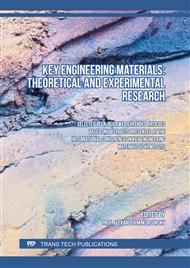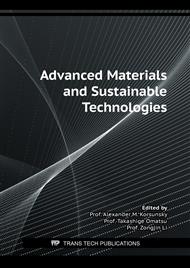[1]
Wang, M., Huang, H., Ma, X., Huang, C., & Peng, X. Copper metal-organic framework embedded carboxymethyl chitosan-g-glutathione/polyacrylamide hydrogels for killing bacteria and promoting wound healing. International Journal of Biological Macromolecules, 187, (2021)699-709.
DOI: 10.1016/j.ijbiomac.2021.07.139
Google Scholar
[2]
Alam, M. N., Bristi, N. J., & Rafiquzzaman, M. Review on in vivo and in vitro methods evaluation of antioxidant activity. Saudi pharmaceutical journal, 21(2), (2013)143-152.
DOI: 10.1016/j.jsps.2012.05.002
Google Scholar
[3]
Tamer, T. M., Hassan, M. A., Valachová, K., Omer, A. M., El-Shafeey, M. E., Eldin, M. S. M., & Šoltés, L. Enhancement of wound healing by chitosan/hyaluronan polyelectrolyte membrane loaded with glutathione: in vitro and in vivo evaluations. Journal of biotechnology, 310, (2020)103-113.
DOI: 10.1016/j.jbiotec.2020.02.002
Google Scholar
[4]
Li, J., Shu, Y., Hao, T., Wang, Y., Qian, Y., Duan, C., Sun, H., Lin, Q., & Wang, C. A chitosan–glutathione based injectable hydrogel for suppression of oxidative stress damage in cardiomyocytes. Biomaterials, 34(36), (2013)9071-9081.
DOI: 10.1016/j.biomaterials.2013.08.031
Google Scholar
[5]
Morris, D., Khurasany, M., Nguyen, T., Kim, J., Guilford, F., Mehta, R., Gray, D., Saviola, B., & Venketaraman, V. Glutathione and infection. Biochimica et Biophysica Acta (BBA)-General Subjects, 1830(5), (2013)3329-3349.
DOI: 10.1016/j.bbagen.2012.10.012
Google Scholar
[6]
Pizzorno, J. Glutathione! Integrative Medicine: A Clinician's Journal, 13(1), (2014)8.
Google Scholar
[7]
Khan, N. U., Ali, A., Khan, H., Khan, Z. U., & Ahmed, Z. Stability studies and characterization of glutathione-loaded nanoemulsion. Journal of cosmetic science, 69(4), (2018)257-267.
Google Scholar
[8]
Bahadoran, M., Shamloo, A., & Nokoorani, Y. D. Development of a polyvinyl alcohol/sodium alginate hydrogel-based scaffold incorporating bFGF-encapsulated microspheres for accelerated wound healing. Scientific reports, 10(1), (2020)1-18.
DOI: 10.1038/s41598-020-64480-9
Google Scholar
[9]
Baker, M. I., Walsh, S. P., Schwartz, Z., & Boyan, B. D. A review of polyvinyl alcohol and its uses in cartilage and orthopedic applications. Journal of Biomedical Materials Research Part B: Applied Biomaterials, 100(5), (2012)1451-1457.
DOI: 10.1002/jbm.b.32694
Google Scholar
[10]
Bharathi, B. S., & Stalin, T. Cerium oxide and peppermint oil loaded polyethylene oxide/graphene oxide electrospun nanofibrous mats as antibacterial wound dressings. Materials Today Communications, 21, (2019)100664.
DOI: 10.1016/j.mtcomm.2019.100664
Google Scholar
[11]
Gaaz, T. S., Sulong, A. B., Akhtar, M. N., Kadhum, A. A. H., Mohamad, A. B., & Al-Amiery, A. A. Properties and applications of polyvinyl alcohol, halloysite nanotubes and their nanocomposites. Molecules, 20(12), (2015)22833-22847.
DOI: 10.3390/molecules201219884
Google Scholar
[12]
Zia, F., Anjum, M. N., Saif, M. J., Jamil, T., Malik, K., Anjum, S., BiBi, I., & Zia, M. A. (2017). Alginate-poly (ethylene) glycol and poly (ethylene) oxide blend materials. In Algae Based Polymers, Blends, and Composites (pp.581-601): Elsevier.
DOI: 10.1016/b978-0-12-812360-7.00016-1
Google Scholar
[13]
Kianfar, P., Vitale, A., Dalle Vacche, S., & Bongiovanni, R. Enhancing properties and water resistance of PEO-based electrospun nanofibrous membranes by photo-crosslinking. Journal of Materials Science, 56(2), (2021)1879-1896.
DOI: 10.1007/s10853-020-05346-3
Google Scholar



